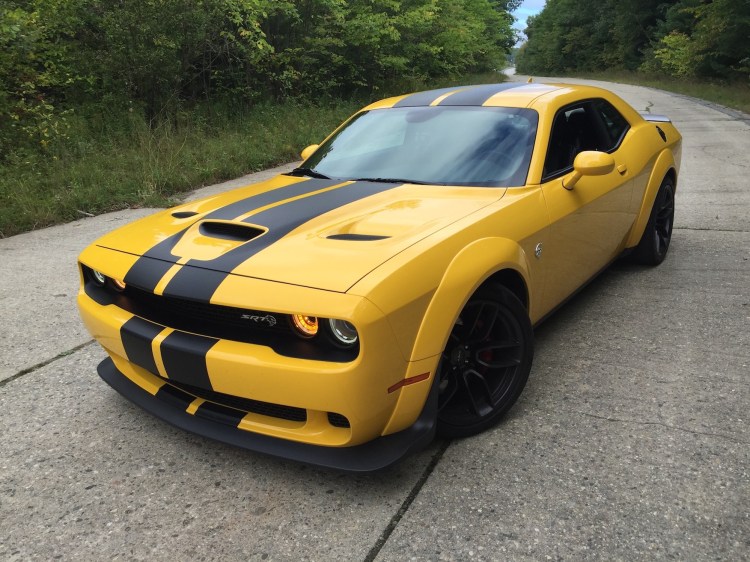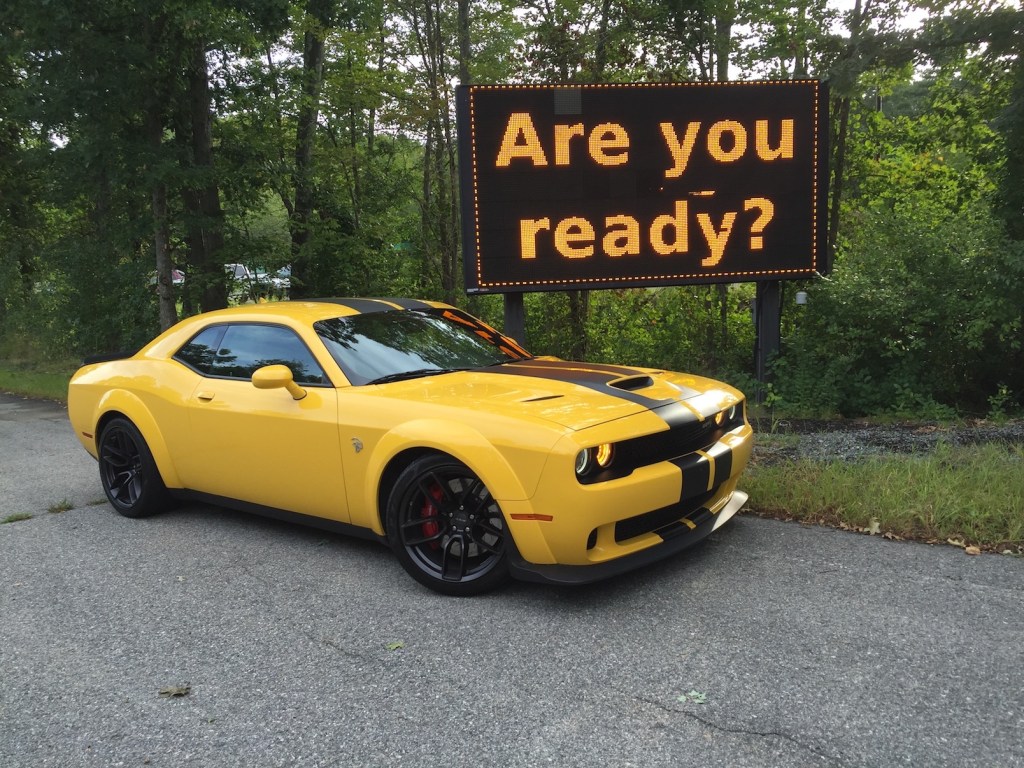In June 2015, an early production Dodge Challenger SRT Hellcat made its debut in New England. Painted a retina-grabbing lime green, this supercharged pony car quickly became legendary throughout the region.
Packing 707-horsepower that produced both a guttural howl under throttle and a high-pitched whine from its belt-driven supercharger, the Hellcat redefined bodacious performance. It went to weddings, family reunions, drive-ins, Corvette shows, drag races – all while becoming the outsized halo vehicle that Dodge planned for.
It made an appearance on television, too, guest-starring with Wayne Carini and his mechanic, Roger, in a memorable illustration of its prolific power on”Chasing Classic Cars.”
For 2018, Dodge added the Demon model to the 11-year-old Challenger platform – a Hellcat on steroids with a mind-bending 840-hp. Dodge also created the car seen here, the Hellcat Widebody. Employing wider Devil’s Rim aluminum wheels and giant 305/35ZR50 Pirelli P-Zero tires, the Widebody gets larger six-piston Brembo brakes, stiffer spring rates, plus two inches of wheel arches on each side to shield the larger tires.
The larger tires are an effort to get more of the Hellcat’s 650-pound/feet of torque to the ground, to provide greater forward acceleration from the incredible thrust now available. While somewhat successful, the supercharged 6.2-liter engine still vaporizes those big Pirelli tires with little provocation.
Teamed with an excellent ZF high-output, eight-speed TorqueFlite automatic transmission, the Hellcat engineers created a pony car that accelerates faster with the automatic (a $2,995 option) than it does with the standard three-pedal setup.
The six-speed manual provides more tactile feel, and driving purists may claim to still prefer rowing their own gearbox, yet the ZF automatic shifts so quickly and so easily that drivers soon become intoxicated with the amazing eighth to third-gear downshifts under full throttle, the rear tires breaking loose despite active traction control, and the car slithering down the road like the devil-ish cat that it pretends to be.
If you insist on manipulating the gears, fine. Dodge provides steering wheel paddle shifters that let you manage gear choices while orchestrating the delicious melody that emanates from the dual-mode exhaust pipes. NASCAR racer comes to mind as the Hellcat provides explosive mechanical symphonies, the bellowing music that makes gearheads crane their necks to see whence it came.
Impressively, the SRT Hellcat cruises quietly, loafing along at only 1,500-RPMs doing 75 mph; peaceful enough inside to easily talk and listen to the excellent Harman Kardon audio system. But when the hammer goes down, there is no mistaking the mission of this rocket: It can propel you to supersonic velocities in the blink of an eye, announcing its intentions to all who are within ear-shot.
Our Widebody sample, festooned in look-at-me Yellow Jacket paint with the optional dual carbon stripes ($995), gathered glances, countless thumbs-up, as well as outsized attention everywhere it went. Buyers might want to be as extroverted as the car’s infamous color schemes, because you will have lots of conversations with strangers.
Despite more than a decade on this same platform – which is essentially an older Mercedes chassis from the days when Daimler-Benz owned Chrysler – the rear-drive Challenger has seen constant improvements and finessing beyond the four-different engines that Dodge utilizes here.
The ZF transmission (used by Mercedes, Porsche, and several other automakers) is obviously a high-point, however adaptive damping (three modes) plus progressive improvements in suspension components enable the latest Hellcat to handle better.
While not as agile as either the Mustang or the Camaro, outweighing each by over 600-pounds, the Challenger provides a compliant ride, roomy trunk, and the largest rear seat in a segment where that may not be the consideration it once was.
Integral to the Hellcat offering is the SRT street & track programming available on the huge U-connect touchscreen. With the Red Key in the driver’s possession (the black valet key reduces peak power to ‘only’ 500-horses), a pilot can choose from steering, throttle, and suspension settings as well as launch control to realize the car’s full potential.
With Challenger pricing starting at $27,295, and climbing to $71,995 for the Hellcat Widebody ($77,275 as shown) Dodge has accomplished what few pundits thought possible. The Challenger, also with an AWD model available, is now outselling Chevy’s Camaro, and closing in fast on Ford’s venerable Mustang. The Dodge Boys would be very happy.
A visceral thrill machine with few competitors, the Challenger SRT Hellcat is even more impressive now than the original sampled three years ago. It is faster, handles better, and still destroys tires with abandon. It will be as popular 20 years from now as the muscle cars that fans loved from the 1960s.
Send questions/comments to the editors.




